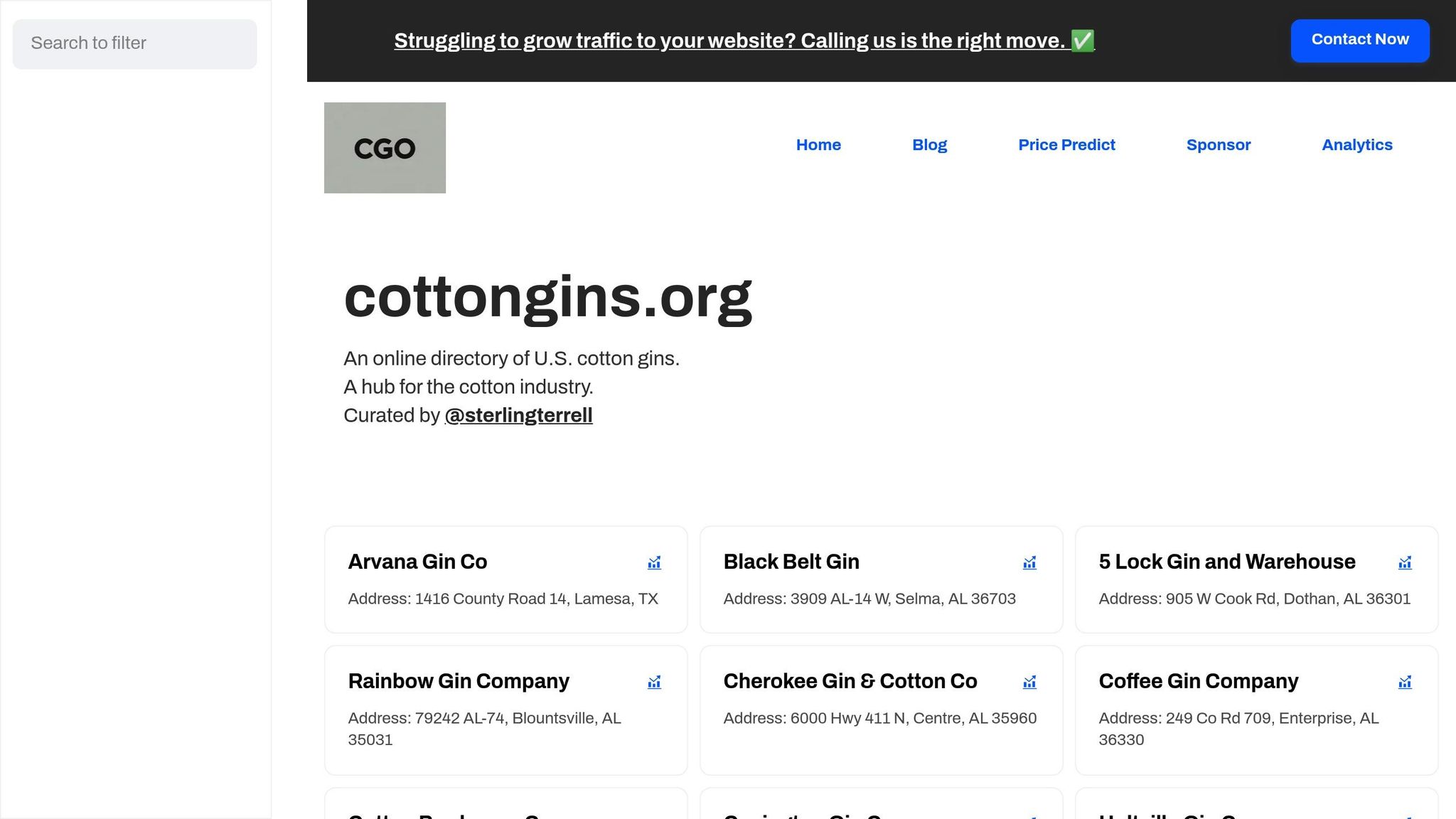The global demand for cotton is increasing, driven by expanding textile industries and a preference for natural fibers. U.S. exporters have a strong position due to high-quality cotton and advancements in irrigation, land use, and emission reductions. However, challenges like high transportation costs, supply chain coordination, and price volatility require careful planning. Key strategies include:
- Cost Control: Use rail for long distances (30–50% cheaper than trucking), optimize warehousing schedules, and negotiate bulk shipping rates.
- Efficient Logistics: Align transportation modes with shipment size and distance, and use real-time tracking to monitor shipments.
- Seasonal Timing: Plan exports around global demand peaks for better pricing and faster sales.
- Technology Integration: Automate processing, use IoT and RFID for shipment tracking, and analyze data for better decision-making.
- Resource Tools: Platforms like cottongins.org help exporters find local cotton gins, improving route planning and supply chain efficiency.
The Threads of Trade: How Global Events are Reshaping Cotton Logistics with Michael Symonanis
Export Logistics and Cost Control
Keeping export costs in check starts with identifying the key expense drivers. Once these are clear, exporters can implement strategies to manage and reduce those expenses effectively.
Main Parts of Export Logistics
Transportation plays a critical role in both cost and efficiency. Choosing between trucking cotton bales to ports or using rail transport can make a significant difference. For long-distance hauls, rail often proves 30–50% cheaper, but it requires sufficient volume and coordination to be a practical solution.
Managing warehousing schedules is another area where costs can be reduced. By aligning storage needs with seasonal production cycles, exporters can cut down on rental, insurance, handling, and inventory costs.
Even smaller expenses, like packaging and documentation, can add up when dealing with large shipments. Ensuring cotton bales meet international packaging standards and that all compliance paperwork is in order helps avoid unnecessary fees and delays.
Port handling and customs clearance also contribute to costs, with terminal charges, customs brokerage fees, and inspection costs all coming into play. Efficient coordination at ports is crucial to avoid delays that could lead to additional expenses.
Understanding these cost components enables exporters to focus on targeted strategies for cutting expenses.
Ways to Cut Logistics Costs
Seasonal inventory management is one of the most effective ways to reduce logistics expenses. For example, a spinning mill managed to cut its logistics costs by 23% by adjusting its replenishment policies and transportation planning to align better with seasonal demand. This approach reduces storage time and ensures transportation loads are optimized.
Transportation mode optimization is another straightforward way to save money. Evaluating and selecting the right transport method based on distance and volume can make a big difference:
| Transport Method | Best For | Cost Efficiency | Key Considerations |
|---|---|---|---|
| Truck | Short distances, remote areas | Flexible, higher cost | Direct to port; limited by volume |
| Rail | Long distances | 30–50% cheaper | Requires volume and hub access |
| Intermodal | Mixed distances | Most cost-effective | Needs careful coordination |
Negotiating bulk shipping rates is another cost-saving tactic. Consistent shipping volumes can lead to better freight rate agreements compared to relying on spot market pricing.
Technology can also play a vital role in cutting costs. Advanced systems can analyze operational data to uncover inefficiencies that are easy to miss with manual tracking. This data-driven approach supports smarter decisions in transportation and storage management.
Collaborative efforts among cotton exporters can further reduce costs. Smaller exporters, in particular, can benefit from partnerships that allow them to share transportation and storage resources, gaining access to volume-based discounts typically reserved for larger operations.
Lastly, optimizing inventory practices to align with seasonal demand helps reduce carrying costs while ensuring timely and reliable deliveries. By staying proactive and strategic, exporters can maintain efficiency without overspending.
Route Planning and Improvement
Balancing cost, speed, and reliability is at the heart of effective route planning. This approach not only trims expenses but also ensures that cotton reaches international markets on schedule, even when external disruptions arise.
Choosing the Right Transport Method
When it comes to international exports, sea freight stands out as a cost-effective option for moving large volumes, though it does come with longer transit times - especially from U.S. Gulf ports to Asia. Domestically, rail transport offers significant savings, typically 30–50% less than trucking for long distances, while efficiently handling high volumes. On the other hand, trucking is ideal for shorter distances or areas where rail access is limited. Combining trucking with rail in an intermodal strategy can further reduce costs.
Several factors influence the choice of transport method, including shipment size, distance to the port, delivery urgency, and available infrastructure. For premium cotton markets, faster delivery and specialized handling may justify higher transportation expenses. Meanwhile, commodity-grade cotton often prioritizes cost efficiency over speed. These decisions form the basis for thorough route performance evaluations.
Analyzing and Improving Shipping Routes
Once the transport method is selected, it's crucial to scrutinize each leg of the journey for inefficiencies. Break down transit times at every stage - from the gin to the port and eventually to the market - to pinpoint bottlenecks.
Weather conditions can heavily influence cotton transport. For instance, Gulf Coast ports are prone to delays during hurricane season, which runs from June through November. Similarly, winter weather in northern states can disrupt rail and truck operations. To avoid setbacks and costly demurrage charges, it's essential to have weather contingency plans in place.
Port congestion is another factor that can disrupt schedules, often varying with the seasons. Major export hubs like Houston, New Orleans, and Savannah provide congestion forecasts, which can help exporters better time their shipments. During peak periods, using alternative ports can minimize delays and keep shipments on track.
It's also wise to monitor political and trade risks, adjusting and diversifying routes as needed to avoid disruptions.
Modern tools make route improvement more accessible than ever. Real-time tracking systems, historical data analysis, and route simulation software provide actionable insights. Regularly reviewing routes, collaborating with shipping partners, and fine-tuning container usage can help adapt to changing market demands while ensuring efficiency and reliability.
Timing Methods for Global Cotton Exports
Timing your cotton exports to align with global demand peaks can help you secure better prices and maximize profits.
Using Seasonal Demand Changes
Cotton demand tends to follow predictable seasonal patterns, which exporters can use to their advantage. Peak demand usually occurs when textile manufacturers ramp up production ahead of new seasons. This creates opportunities for exporters to achieve higher prices and faster sales.
To capitalize on these patterns, it's important to align your replenishment and transportation plans with seasonal demand. This can lead to significant cost savings. Understanding your buyers' production cycles is a key part of this strategy. For example, textile manufacturers often plan their purchases with a three-month lead time. While the timing of demand peaks may vary by region, they are generally consistent enough to allow for effective planning.
Market-responsive inventory management is now the norm. Many exporters review their inventory and adjust replenishment schedules monthly, based on real-time demand and pricing trends. Exporters who align their shipping schedules with these cycles often secure better contracts and pricing. By coordinating shipments with peak demand windows, you can maximize profits. However, this requires careful planning and collaboration with your supply chain to ensure your cotton arrives exactly when buyers need it.
Beyond these seasonal patterns, global economic factors also play a crucial role in determining the best timing for exports.
Adapting to Global Market Trends
Global economic shifts - like trade policies, currency fluctuations, and disruptions at major ports - can significantly impact export timing strategies.
Currency exchange rates are particularly influential. When the U.S. dollar weakens against other major currencies, American cotton becomes more appealing to international buyers. On the flip side, a strong dollar can lead buyers to delay purchases, waiting for more favorable exchange rates.
Trade policies, such as new tariffs, also create timing challenges. For instance, exporters often experience a rush of orders before tariffs take effect, followed by slower periods as markets adjust to the new pricing. Staying informed through trade publications and government updates can help you anticipate these changes and position your inventory effectively.
Political tensions between trading nations can also disrupt timing. Buyers may accelerate orders to avoid potential supply issues or hold off in anticipation of a resolution. Diversifying your market base can help reduce reliance on any single region and its political climate.
To manage these risks, many exporters use futures contracts and hedging strategies. These tools allow you to lock in prices for future deliveries, protecting against fluctuations in demand or pricing.
Real-time market intelligence is another critical tool. Monitoring global cotton production reports, weather forecasts, and economic data from key markets can help you identify the best export windows. Additionally, maintaining flexible shipping arrangements - such as holding inventory in strategic locations and partnering with multiple transportation providers - enables you to adapt quickly to unexpected market shifts. This flexibility ensures you're ready to seize opportunities as they arise.
sbb-itb-0e617ca
Using Technology to Improve Export Efficiency
By focusing on streamlined routes and cost savings, technology has revolutionized cotton export operations, delivering tangible benefits that directly boost profitability. Over the past 40 years, U.S. cotton growers and exporters have seen notable advancements, including a 58% increase in irrigation water use efficiency, a 30% improvement in land use efficiency, and a 25% reduction in greenhouse gas emissions.
These gains are the result of implementing automation, tracking systems, and data integration across the export supply chain. Such measures have helped cut logistics costs, which typically make up 7.87% of manufacturing sales.
Automation in Cotton Processing and Packaging
Automated systems for processing and packaging have transformed cotton exports by speeding up operations, reducing errors, and cutting costs. These systems handle repetitive tasks efficiently, allowing exporters to focus on scaling operations.
Warehouse automation plays a key role here. Tools like automated storage and retrieval systems, conveyor belts, and robotic palletizers streamline order fulfillment while lowering labor expenses. With these technologies, exporters can handle larger volumes with smaller teams, resulting in significant savings that can be passed on to international buyers.
In the textile industry, companies adopting automation have reported faster processing times and greater accuracy in fulfilling orders. This directly benefits international buyers by ensuring timely and reliable deliveries, which are critical in global trade.
Data integration further enhances these automated systems by connecting every step of the supply chain - from harvesting and ginning to logistics. This seamless flow of information allows for precise adjustments in processing rates, reducing energy consumption and costs. Additionally, integrated systems make it easier to track sustainability metrics and compliance documentation, simplifying export operations.
Tracking and Monitoring Shipments
Real-time tracking has become a cornerstone of efficient supply chains, offering transparency that is critical in the competitive global cotton market. Technologies like IoT sensors, GPS, and RFID provide exporters and their clients with detailed, real-time updates throughout the shipping process.
IoT-enabled tracking offers data on location, temperature, and humidity, which is essential for preserving cotton fiber quality during transit. By monitoring these conditions, exporters can protect their reputation and ensure the buyer's investment is secure, reducing disputes and fostering stronger business relationships.
GPS and RFID technologies work together to provide comprehensive tracking solutions. GPS delivers precise location updates, while RFID tags store shipment details such as origin, processing dates, and quality specifications. This combination allows exporters to offer clients detailed shipment histories and quality assurance documentation, enhancing trust and reliability.
Digital platforms and supply chain management software further improve coordination among gins, transporters, and exporters. These tools help minimize delays, optimize inventory management, and provide a unified view of the entire export process. By identifying potential issues early, stakeholders can address them before they escalate into costly problems.
Data analytics and predictive modeling add another layer of efficiency by forecasting demand, streamlining shipping schedules, and mitigating disruptions. These tools enable exporters to proactively manage challenges like weather delays or port congestion, ensuring smoother operations.
Investing in advanced tracking technologies doesn’t just improve operational efficiency - it also gives exporters a competitive edge. Clients increasingly expect real-time updates and detailed documentation, and those who meet these expectations often find they can secure higher prices and build lasting relationships with international buyers.
Using cottongins.org to Improve Supply Chain

Choosing the right cotton gin can make a big difference in export operations. By partnering with the right gins, exporters can streamline route planning and keep costs in check. Using tools like detailed gin directories and forming strategic relationships, exporters can create smoother pathways from farms to international markets. This approach lays the groundwork for tapping into local gin resources to refine logistics.
Finding Local Cotton Gins
The directory on cottongins.org is a valuable resource for exporters, offering detailed information about cotton gins across major cotton-producing states in the U.S. Each listing includes a precise address, making it easier to plan routes and optimize logistics.
Having exact addresses allows exporters to input them into route-planning systems, helping them figure out the best transportation paths and weigh processing options based on overall logistics costs.
What’s more, the directory isn’t limited to long-established cotton regions. It also includes states like Arizona, New Mexico, and Virginia, which provide flexibility for sourcing and processing. This geographic variety is especially helpful when dealing with supply chain disruptions or when looking for cost-effective processing alternatives.
By offering a clear view of processing options, the directory boosts supply chain transparency. It enables exporters to research facilities thoroughly, plan for backup processing locations, and build dependable relationships with multiple gins. This ensures steady capacity, even during the busiest harvest seasons.
Sponsorship Opportunities
Cottongins.org doesn’t just enhance logistics; it also helps strengthen industry connections. The platform offers three sponsorship levels, catering to different goals and budgets.
- Sponsored Posts: For $200 per post, businesses can gain immediate visibility at the top of the site, along with social media promotion and permanent archiving.
- Official Sponsorship: At $200 per month, this option provides ongoing brand exposure.
- Featured Sponsorship: For $400 per month, businesses can enjoy premium visibility and additional benefits, ensuring regular engagement with industry professionals.
Being active on cottongins.org creates opportunities to connect with gin operators, exporters, and service providers. Sponsored content can also be a platform to share market insights, sustainability efforts, or innovations, helping exporters position themselves as leaders in the industry and attract new business opportunities.
Conclusion: Main Points for Better Cotton Exports
Improving cotton exports depends on keeping costs under control, planning routes efficiently, and timing shipments to match seasonal demand. When logistics are carefully aligned with market needs, and automated tracking systems are in place, exporters can cut expenses and gain a competitive edge.
Incorporating technology plays a key role in making exports more efficient. Automating processes like packaging, shipment tracking, and processing can simplify operations while providing better visibility throughout the supply chain. Tools like cottongins.org, which offers a detailed directory of U.S. cotton gin locations, can further aid in supply chain planning by ensuring quick access to local processing facilities.
Final Thoughts on Export Improvement
To achieve success in cotton exports, constant refinement is essential. Keeping a close eye on critical metrics - like logistics costs, delivery times, and environmental impact - helps exporters spot opportunities for improvement. Staying competitive means adapting to shifts in global markets while maintaining high standards in operations. By combining strategic planning with real-time technological tools, exporters can streamline their processes and build strong, lasting partnerships across the globe.
FAQs
How can technologies like IoT and RFID improve cotton export logistics?
Integrating IoT (Internet of Things) and RFID (Radio Frequency Identification) into cotton export logistics can make operations much smoother and more reliable. These technologies allow for real-time tracking and monitoring, ensuring shipments stay on schedule and in the best possible condition.
Take IoT sensors, for instance - they can track key environmental factors like temperature and humidity during transit. This helps maintain the quality of the cotton throughout its journey. On the other hand, RFID tags are a game-changer for inventory management. They provide accurate shipment tracking, minimizing errors and delays along the way.
By using these tools, exporters can streamline their supply chains, cut costs, and boost dependability in global markets.
What factors should you consider when deciding between trucking and rail for long-distance cotton transportation?
When deciding between trucking and rail for transporting cotton across long distances, it's essential to weigh cost, delivery speed, and capacity. Trucking generally offers quicker delivery and greater flexibility, making it ideal for shorter routes or shipments that need to arrive promptly. On the other hand, rail tends to be a more economical choice for moving large quantities of cotton over longer distances.
It's also important to consider the infrastructure available near your cotton gin or storage facility. Proximity to rail terminals or major highways can significantly affect the efficiency of your logistics. For more detailed planning, you can use resources like cottongins.org to locate nearby cotton gins and refine your transportation approach.
How do currency changes and trade policies affect the timing of cotton exports?
Currency shifts and trade policies play a key role in determining when cotton exports make the most sense. For example, when the U.S. dollar is strong, American cotton becomes pricier for international buyers, which can lead to a drop in demand. Conversely, favorable exchange rates can make U.S. cotton more appealing and competitive on the global stage.
Trade policies, like tariffs or export restrictions, also influence export timing. Exporters might need to adjust their schedules to accommodate policy changes or capitalize on short-term trade agreements. Keeping a close eye on global economic trends and regulatory updates is crucial for fine-tuning export strategies.


